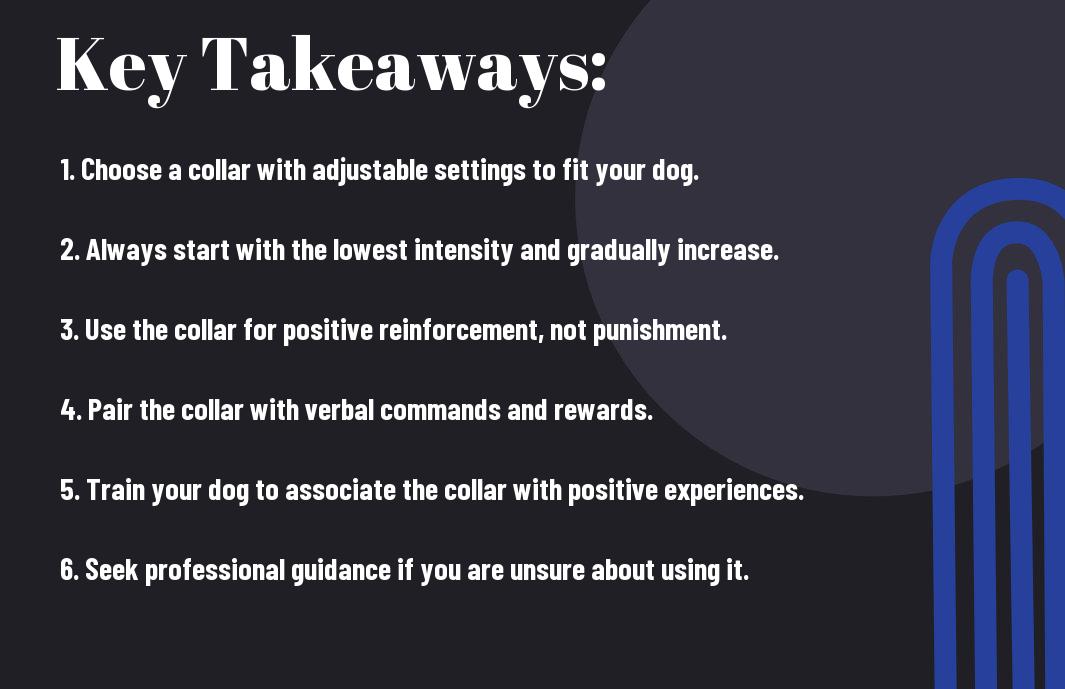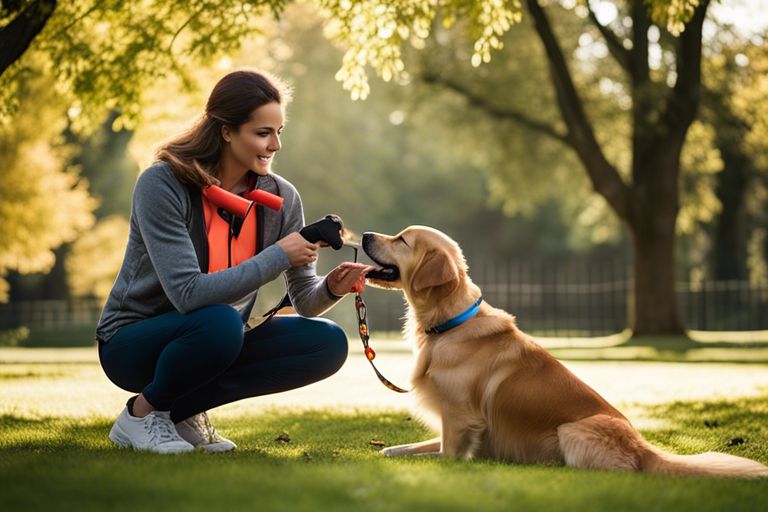Utilizing a dog training collar properly can be a valuable tool in teaching your pets the behaviors you desire. However, it is important to understand how to safely and effectively use these collars to avoid harming your animal or causing unnecessary stress.
First and foremost, it is essential to select the correct collar for your dog as well as being knowledgeable about how to fit it securely and safely. It is also essential to educate yourself on the proper techniques for training with a training collar to promote positive reinforcement and minimize any potential risks.
Key Takeaways:
- Proper Fit: Ensure that the training collar fits snugly but not too tight on your dog’s neck.
- Appropriate Use: Use the training collar as a tool for reinforcement, not punishment, and only when necessary.
- Consistent Training: Pair the use of the training collar with consistent and positive reinforcement training methods.
- Clear Communication: Always give clear and consistent signals to your dog when using the training collar.
- Follow Instructions: Read and follow the manufacturer’s instructions for the specific training collar you are using to ensure safe and effective use.

Understanding Dog Training Collars
Clearly, dog training collars are a powerful tool for training your dogs. They come in different types and have different functionalities, so it’s important to understand them before using one. If you’re looking for more information on how to use your e-collar during training, you can check out this discussion on How do you use your e-collar during training?
Types of Dog Training Collars
Any dog training collar falls into one of three main categories: shock collars, vibration collars, or citronella collars. Each type works differently to correct undesirable behavior. Importantly, it’s crucial to select a collar that suits your dog’s size and temperament. Any use of the dog training collar must also be consistent and timely, with appropriate rewards for desired behaviors. The information is broken down into the following table:
| Type | Functionality |
|---|---|
| Shock Collars | Deliver an electric shock to the dog’s neck |
| Vibration Collars | Emits vibration as a warning or correction |
| Citronella Collars | Sprays a burst of citronella to deter behavior |
How Dog Training Collars Work
Any dog training collar works by providing a form of stimulus to the dog when it exhibits unwanted behavior. This stimulus can range from a mild vibration to a sharp electric shock. It’s important to note that the effectiveness of a training collar depends on the dog’s temperament and the consistency of its use. The training collar should always be used as a last resort after other training methods have failed.
The potential for misuse of shock collars is a concern for many dog trainers and behavior experts. The positive aspect of training collars is when they are used correctly and responsibly, they can be an effective tool for modifying unwanted behavior in dogs.

Preparing for Training
Unlike traditional training methods, using a dog training collar requires careful preparation and understanding of your dog’s behavior and needs. Before using a training collar, it’s essential to assess your dog’s temperament and learning style, as well as establish clear training goals.
Assessing Your Dogs’ Temperament and Learning Style
Preparing for training with a dog training collar starts with assessing your dogs’ temperament and learning style. This will help you determine the most effective and safe training methods. Observe your dogs’ behavior in different situations and interactions with other dogs and humans. Understanding their learning style will help you tailor the training to your dogs’ specific needs for better results.
Establishing Training Goals
An essential step in preparing for training with a dog training collar is establishing clear training goals. Identify what behaviors you want to address or improve, and set achievable milestones for your dogs. This will guide your training sessions and keep them focused and effective.
With careful preparation and understanding of your dogs’ behavior and needs, using a dog training collar can be a valuable tool in shaping your dogs’ behavior and obedience.
Safety and Ethics of Collar Use
Not only is it important to use dog training collars correctly, but it is also crucial to consider the safety and ethical implications of their use. Understanding the risks, taking precautions, and considering ethical considerations are essential for the responsible use of training collars.
Understanding the Risks and Precautions
With any training tool, there are potential risks involved, and it is important to be aware of these when using a dog training collar. Overuse or misuse of the collar can lead to physical and psychological harm to the dog, including skin irritation, stress, and fear. It is crucial to carefully read and follow the instructions provided by the manufacturer and to seek guidance from a professional dog trainer if unsure. Additionally, it is important to regularly check for any signs of discomfort or distress in the dog when using the collar.
Ethical Considerations in Training
Ethics play a significant role in the use of training collars for dogs. It is essential to consider the well-being and comfort of the dog at all times, ensuring that their training experience is as positive as possible. Using a training collar should not be a substitute for proper training and positive reinforcement methods. Train your dogs with respect and kindness, and always prioritize their welfare above all else.
Plus, it is important to remember that every dog is different, and what works for one may not work for another. Understanding and respecting the individual needs and preferences of each dog is crucial for ethical training.

How to Fit a Training Collar
Keep your dog’s comfort and safety in mind when fitting a training collar. It’s important to fit the collar properly to ensure it is effective and doesn’t cause any harm to your dogs. For a more in-depth guide on how to use a Remote Dog Trainer: How To Use a Dog Training Collar, check out our comprehensive guide.
Fitting the Collar Properly
One key consideration when fitting the collar is to ensure it is snug but not too tight. You should be able to fit two fingers between the collar and your dog’s neck. This will allow for proper communication with the collar without causing discomfort or injury to your dog.
Another important aspect of fitting the collar is to make sure the contact points are in direct contact with your dog’s skin. This ensures that the collar’s signals are effectively communicated to your dog.
Ensuring Comfort and Avoiding Injury
Collar fit is crucial to ensuring your dog’s comfort and avoiding injury. It’s important to regularly check the fit of the collar, especially as your dog grows or gains/loses weight. Proper fit will prevent skin irritation or damage to your dog’s neck.
Collar placement and fit are essential to promoting positive training outcomes and ensuring your dog’s safety and well-being during training sessions. Always monitor your dog’s response to the collar and make adjustments as needed to maintain a comfortable fit.
Basic Training Techniques
For best results when using a dog training collar, it is important to start with the basic training techniques. These techniques will help to establish a strong foundation for further training and ensure the safety and well-being of your dogs.
First and foremost, it is essential to properly fit the training collar on your dogs. The collar should be snug enough to stay in place, but not so tight that it causes discomfort or restricts the dogs‘ breathing. It is important to regularly check the fit of the collar as your dogs grow and change.
When beginning training, start with simple commands such as sit, stay, and come. Use the training collar to gently guide and encourage your dogs to follow these commands. Be sure to reward your dogs with treats and praise when they successfully obey the commands, reinforcing positive behavior.
It is crucial to always use the training collar safely and responsibly. Avoid using excessive force or punishment when using the collar, as this can lead to physical and emotional harm to your dogs. Additionally, never leave the training collar on your dogs unsupervised, as it can pose a potential danger if caught on objects or if your dogs attempt to chew on it.
By implementing these basic training techniques with the use of a dog training collar, you can effectively and safely train your dogs to obey commands and behave appropriately in various situations.
FAQ – Using a Dog Training Collar
Q: What is a dog training collar?
A: A dog training collar is a tool used to aid in training dogs by delivering a controlled and adjustable stimulation, either through sound, vibration, or static correction, to deter unwanted behaviors and reinforce positive ones.
Q: How does a dog training collar work?
A: Most dog training collars operate through a remote control that allows the owner to administer the chosen stimulation when the dog exhibits a specific behavior. This helps the dog associate the behavior with the stimulation, resulting in a change in behavior over time.
Q: Is using a dog training collar safe for my dog?
A: When used correctly, and under the guidance of a professional trainer, a dog training collar is generally safe for most dogs. It is essential to carefully follow the instructions and use the lowest effective level of stimulation to avoid causing undue stress or discomfort to the dog.
Q: What are the best practices for using a dog training collar?
A: It is crucial to begin by thoroughly reading and understanding the instructions for the specific training collar being used. Always start with low levels of stimulation and only increase if needed. It is also essential to pair the use of the collar with positive reinforcement and consistency in training.
Q: Are there specific training collars for different types of behaviors?
A: Yes, there are different types of training collars designed for specific training needs. For example, there are bark control collars for excessive barking, remote training collars for off-leash training, and containment system collars for boundary training. It is important to select the appropriate collar for the specific behavior being addressed.
